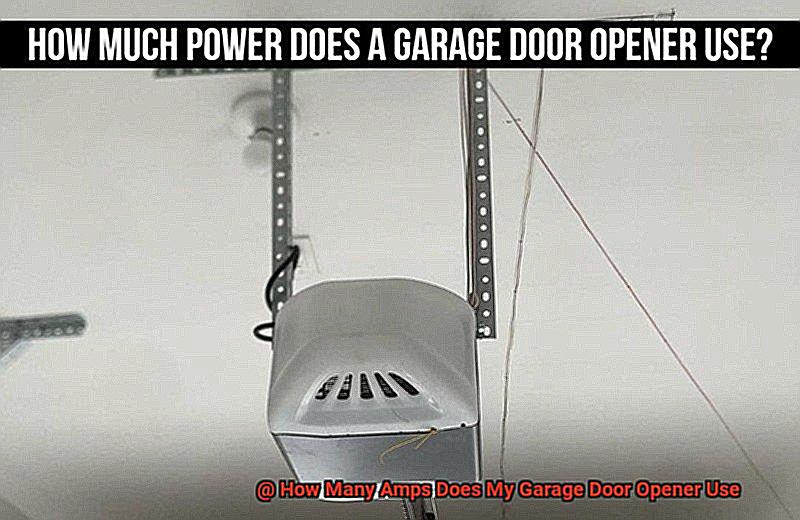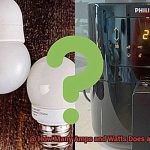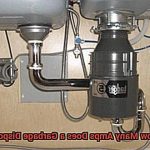Have you ever wondered how much electricity your garage door opener is using? It’s easy to overlook this small but mighty device that lifts and lowers your garage door. However, understanding how many amps your garage door opener uses can actually be quite beneficial when it comes to keeping your garage door in top shape and managing your energy consumption.
The good news is that most modern garage door openers are designed to be energy-efficient and typically use between 2-4 amps of electricity. But if you have an older model or a heavier door, you may require more power, which could result in higher energy bills.
By knowing the amps your garage door opener is using, you’ll be better equipped to troubleshoot any issues that may arise with the opener, such as it not working correctly or tripping your circuit breaker. Additionally, understanding the electrical requirements of your garage door opener can help you plan for any future electrical needs in your garage, such as adding a workbench or charging station for an electric car.
Whether you’re looking to save money on energy costs or simply want to stay informed about how your home functions, knowing how many amps your garage door opener uses is a crucial step towards maintaining a safe and efficient home. So why not take a few moments to check out the electrical specifications of your garage door opener today?
What is an amp?
Contents
- 1 What is an amp?
- 2 How are amps used in garage door openers?
- 3 Factors Affecting Amp Usage
- 4 Type of Garage Door Opener
- 5 Motor Horsepower
- 6 Standby Power Usage
- 7 Average Amp Usage for Garage Door Openers
- 8 Determining the Amp Rating of Your Specific Garage Door Opener
- 9 Benefits of Knowing the Amp Rating of Your Garage Door Opener
- 10 Common Misconceptions About Amps and Garage Door Openers
- 11 Conclusion
In simple terms, an ampere, or “amp” for short, measures the flow of electrical current in a circuit. Think of it like water flowing through a pipe – amps represent the volume of water flowing through, while voltage represents the pressure pushing it.
Now, let’s focus on how this applies to your garage door opener. The unit’s amp rating is typically listed on the device or in its documentation, indicating how much electricity it will draw during operation. However, keep in mind that this rating refers to the maximum amount of amps it can handle, not necessarily the exact amount it will use regularly.
So, how many amps does a garage door opener typically use? It varies depending on the type of opener you have installed. For instance, a chain-driven garage door opener may use more amps than a belt-driven one. However, most garage door openers use between 2-4 amps during operation.
If you want to know your specific garage door opener’s exact amp rating, consult the owner’s manual or contact the manufacturer directly. This information is vital when troubleshooting any electrical issues or when replacing parts. Moreover, knowing your garage door opener’s amp rating can help you calculate your overall electrical usage and determine whether your home’s electrical system can handle additional appliances or devices.
It’s worth noting that while the amp rating is helpful when choosing a garage door opener, it’s not an indicator of energy efficiency alone. Other factors such as motor horsepower and standby power usage also impact your overall energy consumption.
How are amps used in garage door openers?
Amps, or amperes, are the measure of electrical current flowing through a circuit. In garage door openers, amps determine the power required by the motor to function efficiently.
To put it in simpler terms, think of amps like water flowing through a pipe. The amount of water that can flow through a pipe is determined by its size and the pressure pushing it. Similarly, the amount of electrical current that can flow through a circuit is determined by its amps and voltage. In the case of garage door openers, their amp rating indicates how much electricity they draw during operation.
The amps required by your garage door opener depend on the size and type of motor it has. Smaller garage door openers require less amperage than larger ones for optimal performance. However, it’s important to note that amps are not the same as voltage, which is another crucial factor in determining the power requirements of a garage door opener.
To determine how many amps your garage door opener uses, you can consult the owner’s manual or check the motor specifications. Most garage door openers have this information readily available. Alternatively, you can use a clamp meter to measure the amps being drawn by the motor when it’s in operation if you’re uncertain.
During normal operation, most garage door openers draw between 2-4 amps. However, this can vary depending on factors such as the weight of the door, how often it’s used, and the age and condition of the motor. It’s crucial to ensure that your garage door opener doesn’t draw too much power or exceed its amperage rating as this could lead to damage or even electrical fires.
Factors Affecting Amp Usage
In this article, I will share with you the most common factors that can affect your garage door opener’s amp usage.
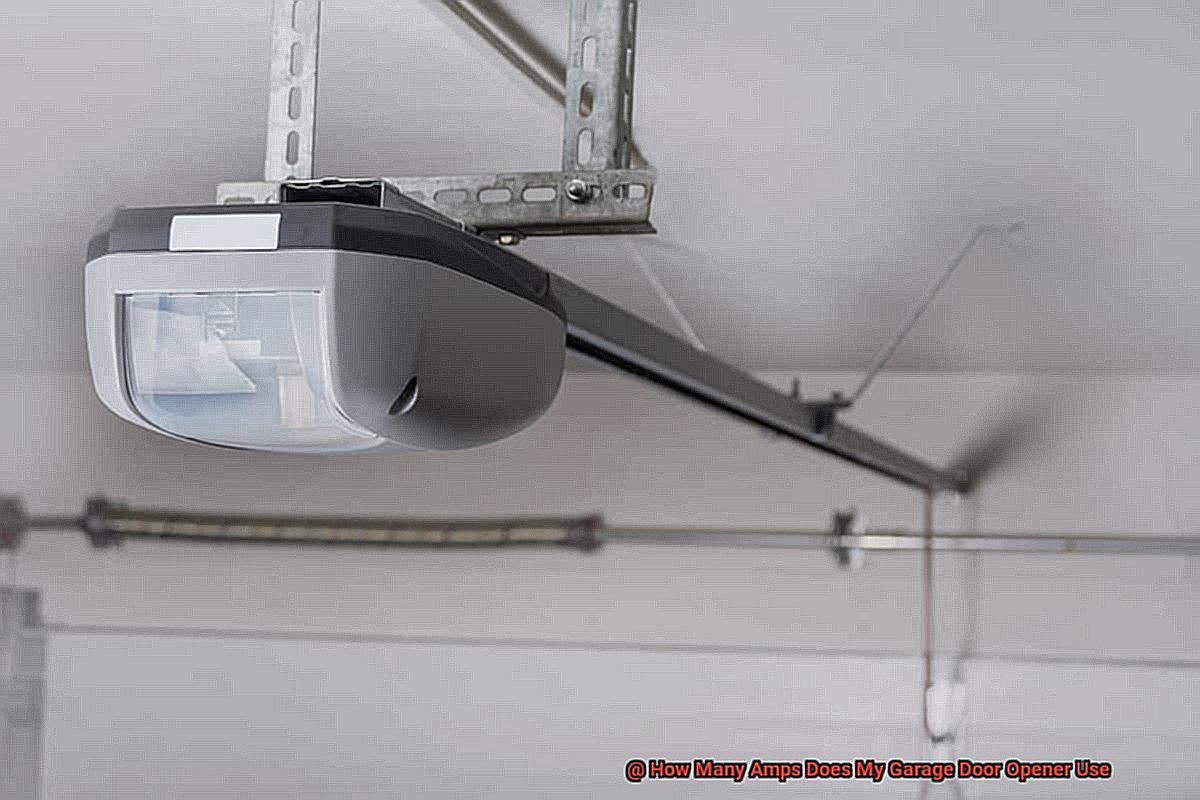
The size and power of the motor are among the most significant factors that can impact amp usage. The larger and more powerful the motor, the more amps it will use. A standard garage door opener motor usually requires between 1 to 2 amps when it is operating. However, if you have a larger motor, it will require more amps to function correctly.
Another factor that can affect amp usage is the age and condition of your garage door opener. Older models tend to use more energy and may require more amps to operate than newer models. Regular maintenance of your garage door opener is crucial to ensure it is in good condition and not using more energy than necessary.
Moreover, the type of garage door opener you have can also impact amp usage. Chain-driven openers tend to use more energy compared to belt-driven or screw-driven openers. This is because chain-driven openers require more power to lift and lower the heavy chain mechanism.
External factors such as temperature and weather conditions can also impact amp usage. In extremely hot or cold climates, your garage door opener may need to use more energy to operate than in moderate temperatures.
If there are any obstructions or resistance in the door’s movement (such as snow or ice), the motor may need to use more amps to operate.
Type of Garage Door Opener
Knowing this information can help you make informed decisions about energy usage and reduce your energy bills. So, let’s dive right into it.
When it comes to amps usage, the type of garage door opener you have is the first thing to consider. There are three main types: chain-drive, belt-drive, and screw-drive. Each has its unique features and advantages.
Chain-drive garage door openers are the most common type and use a chain to pull the door up and down. They tend to be more affordable but may be noisier than other types. On average, a chain-drive opener uses between 4-6 amps while operating.
Belt-drive garage door openers use a rubber belt instead of a chain to operate the door. They are typically quieter than chain-drives and are perfect if you have living spaces above or near the garage. On average, a belt-drive opener uses between 3-5 amps while operating.
Screw-drive garage door openers use a threaded rod to lift and lower the door. They tend to be quieter than chain-drives but may require more maintenance due to their moving parts. On average, a screw-drive opener uses between 3-5 amps while operating.
If you’re looking for a more energy-efficient option, DC-powered garage door openers are worth considering. They use less energy than AC-powered openers and often come with additional features like battery backup and smooth operation. However, they may cost more upfront.

Knowing the type of garage door opener you have is an essential starting point in determining its amps usage. You can further investigate by checking the manufacturer’s specifications or using a clamp meter to measure the amps while the opener is in operation.
Motor Horsepower
Understanding the motor horsepower can help you make informed decisions about its energy consumption and potential cost savings. As an expert in this field, I’m here to give you all the information you need to understand how to calculate the motor horsepower of your garage door opener.
Motor horsepower refers to the amount of power that drives your garage door opener. Most garage door openers require a motor horsepower of 1/2 or 3/4, but there are models available with 1 or 1 1/4 horsepower motors. Remember, the higher the horsepower, the more energy it consumes.
To determine the amount of amps that your garage door opener uses, you will need to know its wattage rating. You can typically find this information on the label of the motor or in the owner’s manual. Once you have this information, you can use a simple formula to calculate amperage: amps = watts/volts.
For example, if your garage door opener has a wattage rating of 600 watts and operates on 120 volts, then the amperage would be 5 amps. Keep in mind that the amperage may vary depending on how often you use your garage door opener and how long it runs for each time. If your garage door opener is older or has not been maintained properly, it may consume more energy than a newer model.
By understanding the motor horsepower and amperage of your garage door opener, you can make educated decisions about energy efficiency. Checking the wattage rating and calculating amperage can give you an accurate estimate of its energy usage. Taking charge of your garage door opener’s energy consumption can help you save money on your energy bills.
Knowing the motor horsepower of your garage door opener is crucial for reducing your energy bills. By following these simple steps outlined above, you can calculate the amperage and make educated decisions about energy efficiency.
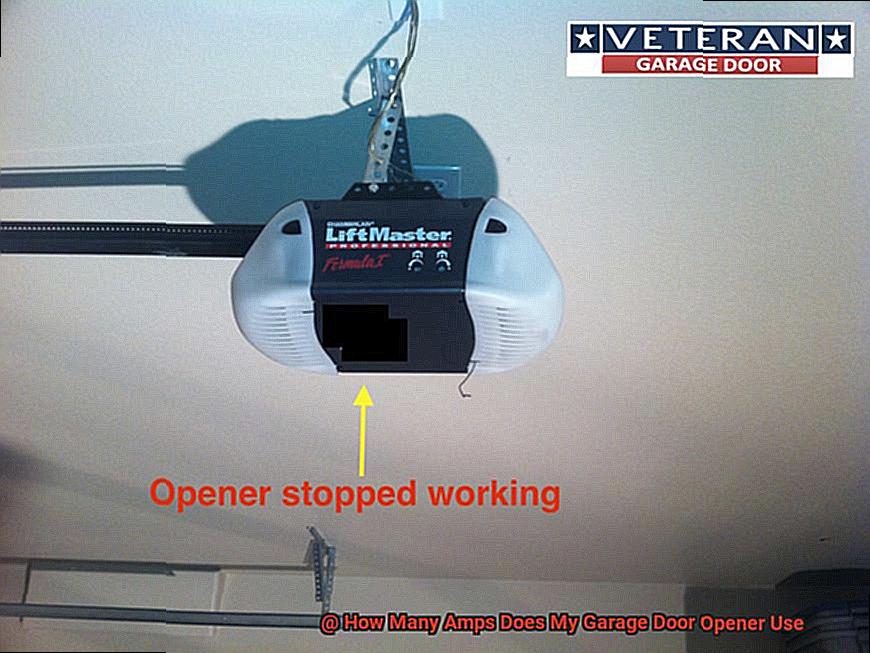
Standby Power Usage
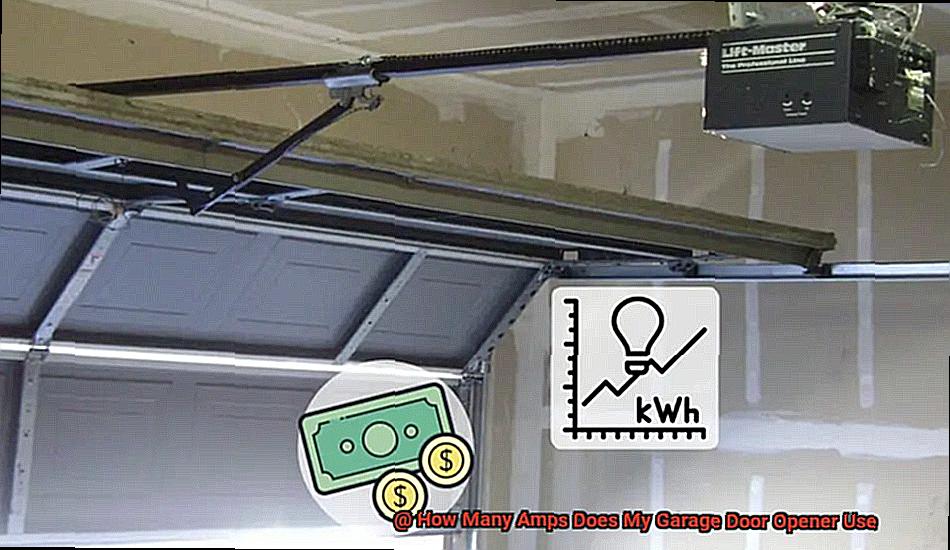
Standby power usage is the energy consumed by electronic devices even when they’re not in use but remain plugged in. This may seem like a small amount of energy, but it can add up over time and contribute to wasteful energy consumption and higher electricity bills.
Did you know that some garage door openers consume up to 10 watts of standby power? That’s a significant amount of energy usage. To reduce your standby power consumption, you can consider purchasing an ENERGY STAR rated garage door opener. These models are designed to be energy-efficient and have lower standby power consumption, which can ultimately save you money.
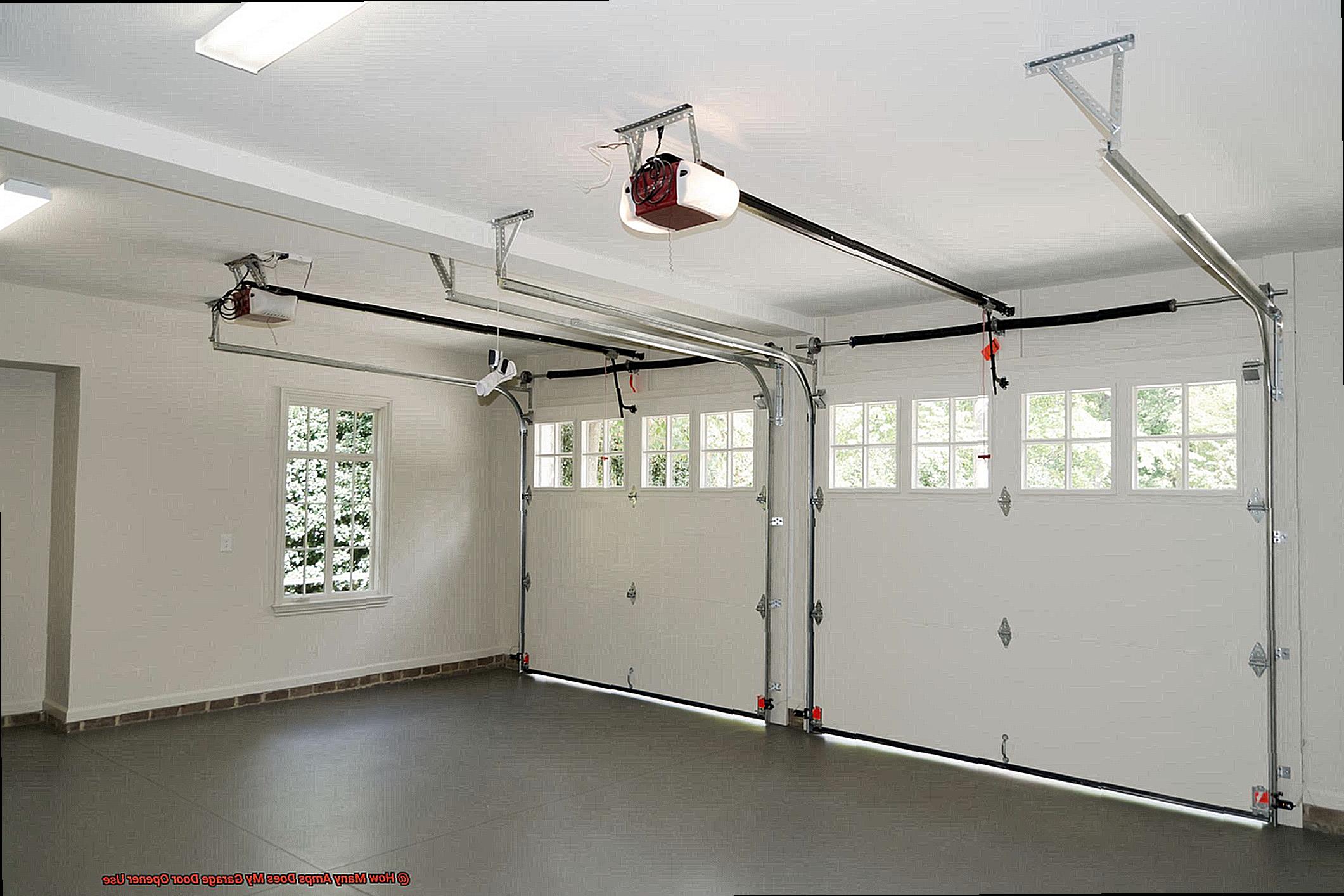
Another easy way to reduce standby power usage is to unplug your garage door opener when it’s not in use or use a power strip with an on/off switch. By taking these simple steps, you can significantly reduce your energy consumption and save money on your electricity bill.
Reducing standby power usage isn’t just about saving money – it’s also about making a positive impact on the environment. By doing so, you can help reduce your carbon footprint and contribute to a more sustainable future for generations to come.
In conclusion, reducing standby power usage is an important aspect of making your garage door opener more energy-efficient and environmentally friendly. Whether it’s choosing an ENERGY STAR rated model or unplugging your device when not in use, every little bit counts. By taking these steps, you’re not only saving money but also making a big difference in the long run.
Average Amp Usage for Garage Door Openers
Firstly, it’s important to note that the average amp usage for garage door openers can vary depending on the type and model. However, most garage door openers typically use between 2 to 4 amps during operation. This is a relatively low amount of power consumption, especially when compared to other household appliances.
It’s important to keep in mind that the amp usage can fluctuate during the different stages of the garage door opening and closing process. For instance, when the garage door is initially opening or closing, it may require a higher amount of power due to the motor working harder to move the door. Once the door is in motion, however, the amp usage will typically decrease.
It’s also worth noting that older garage door openers may use more amps than newer models. This is because older models may not have as efficient motors or may not be designed to conserve energy like newer models. So, if you have an older model, it might be time for an upgrade.
To determine your garage door opener’s average amp usage, you can check its specifications in the owner’s manual or by contacting the manufacturer. This information can help you better understand your device’s energy consumption and potentially make adjustments to reduce your overall energy usage.
In conclusion, knowing your garage door opener’s average amp usage is crucial in understanding its energy consumption and making informed decisions about your energy usage. By doing so, you can contribute towards a greener and more sustainable future.

Determining the Amp Rating of Your Specific Garage Door Opener
One critical aspect of achieving this is determining the amp rating of your specific garage door opener.
Think of it this way: just like how your body requires a certain amount of nutrients to function correctly, your garage door opener needs a specific amount of electrical current to operate safely and efficiently. Determining the amp rating of your garage door opener is like checking the nutrition label on your favorite snack – it ensures that you’re getting precisely what you need to power through your day.
To determine the amp rating of your garage door opener, start by locating the circuit breaker that controls the power supply to your garage. Once you’ve found it, turn off the power to your garage and remove the cover plate from your garage door opener’s electrical box.
Inside the electrical box, you’ll find a label that lists various specifications for your garage door opener, including its amp rating. The amp rating is typically listed as a range, such as 6-10 amps or 8-12 amps.
But here’s where things get interesting: different factors can affect the amp rating of your garage door opener. For example, the weight and size of your garage door or features like automatic lighting or battery backup systems can influence the required amperage.
Once you’ve determined the amp rating of your specific garage door opener, it’s crucial to ensure that your electrical system can handle this amount of current. If you’re unsure whether your current setup is up to the task, consult with a licensed electrician before proceeding with installation or operation.
Benefits of Knowing the Amp Rating of Your Garage Door Opener
Just like how your body needs the right amount of nutrients to function correctly, your garage door opener requires a specific amount of electrical current to operate safely and efficiently. By checking the amp rating, you can ensure that your garage door opener is getting the right amount of power it needs to power through your day.
Knowing the amp rating of your garage door opener offers several advantages that go beyond just keeping it safe. Firstly, it helps ensure that your garage door opener is functioning correctly and safely. With this information, you can determine if your garage door opener is compatible with other electrical appliances in your home without overloading the circuit. This knowledge can help you avoid potential safety hazards.
Secondly, understanding the amp rating of your garage door opener can help you save on energy bills. If your garage door opener uses more amps than necessary, it could be consuming more electricity than it needs to, leading to higher energy bills. By adjusting your usage accordingly based on the amp rating, you can reduce energy consumption and save some money.
Thirdly, knowing the amp rating can also help you troubleshoot any issues with your garage door opener. If it’s not working correctly or frequently tripping a circuit breaker, understanding the amp rating can help you identify the problem and resolve it quickly. Additionally, if you need to replace a part of your garage door opener, knowing the amp rating can help you ensure that you purchase the right replacement part.
In conclusion, understanding the amp rating of your garage door opener is crucial for its optimal performance and longevity. It helps ensure safety, saves energy, troubleshoots issues, and ensures compatibility with other electrical appliances. So don’t forget to check out the nutrition label on your favorite snack – and the amp rating on your garage door opener.
Common Misconceptions About Amps and Garage Door Openers
One of the biggest misconceptions is that a higher amp rating means a more powerful opener. While amps do represent the amount of electricity used, it doesn’t necessarily translate to a stronger lifting force for your garage door. The horsepower rating is another crucial factor to consider when choosing an opener.
It’s also important to note that not all garage door openers use the same amount of amps. The amount of amps used can vary significantly depending on the type and model of the opener. For example, a chain drive opener may use more amps than a belt drive opener due to differences in their mechanical systems.
However, just because an opener uses fewer amps doesn’t automatically make it more energy-efficient. Other factors like motor type and insulation used can also impact energy consumption. Therefore, it’s vital to consider all aspects of your opener before deciding which one to choose.
Lastly, upgrading to a higher amp opener may not always solve issues with your garage door’s performance. It’s essential to inspect other components such as the condition of the door itself or any damaged parts before making changes to the opener.
Qtq1hcEU-IM” >
Conclusion
In conclusion, knowing how many amps your garage door opener uses is important for safety and functionality.
It’s recommended to consult the manufacturer’s specifications or hire a professional electrician to determine the exact amperage required. By doing so, you can ensure that your garage door opener operates smoothly and efficiently without any electrical issues.
Don’t hesitate to reach out to experts if you have any questions or concerns about your garage door opener’s power usage.
